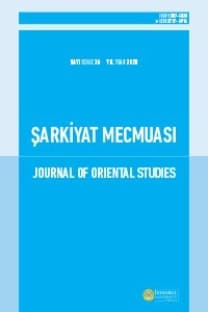Tayyib Sâlih’in Kuzeye Göç Mevsimi Adlı Romanında Şehrin Fezası
Şehrin fezası, şehir, Kuzeye Göç Mevsimi, anlatı ögeleri, Tayyib Salih
The Space of the City in the Novel Season of Migration to the North by Tayeb Salih
space place, city, Mawsim al-Hijrah ilâ al-Shamâl / Season of Migration to the North, narration elements, Tayeb Salih,
___
- Bachelard, Gaston. “Cemâliyyâtu’l-mekân”. Mecelletu’l-aklâm. Trc: Gâlib Helsâ. Bağdad: Dâru’l-Câhiz li’n- neşr ve’t-tevzî, Vizâretu’s-sekâfe ve’l-i‘lâm, 1984.
- Behrâvî, Hasan. Bunyetu’ş-şekli’r-rivâî. Beyrut: el-Merkezu’s-sekâfiyyi’l-Arabî, 1.bs., 1990.
- Derviş, Visâm. »el-Medîne fî rivâyeti İ‘tirâfât Eskrâm li İzzeddîn Mîhûbî”. Doktora Tezi. Câmi‘atu’l-İhve Mentouri. Konstantine: Kulliyetu’l-âdâb ve’l-luğât, 2017.
- Ebû Heyf, Abdullah. »Cemâliyyâtu’l-mekân fi’n-nakdi’l-edebî”. Mecelletu Câmi‘atu Tişrîn li’d-dirâsât ve’l- buhûsi’l- ‘ilmiyye. 1/27 (Dımaşk,2005).
- Ebû Zureyk, Muhammed. el-Mekân fi’l-fenn. Amman/Ürdün: Vizâretu’s-sekâfe, 2003.
- el-Cubûrî, Muhammed Felîh. el-İtticâhu’s-sîmyâî fî nakdi’s-serdi’l-Arabî el-hadîs. Cezair: Menşûratu’l-ihtilâf, 1.bs.,2013.
- el-Kâsım, Ahmed Mahmûd. Kırâ’a fî rivâyeti Mevsimi’l-hicreile’ş-şimâl. Mevkı‘ elektronî: el-Hivâr el- Mutemedden: 2359 (Online: 31.7.2008).
- en-Nablûsî, Şâkir. Cemâliyyâtu’l-mekân fi’r-rivâyeti’l-Arabiyye. Beyrut: el-Muessesetu’l-Arabiyye li’d-dirâsât ve’n-neşr, 1.bs., 1994.
- Medkan, Kulsûm. »Delâletu’l-mekân fî rivâyeti Mevsimi’l-hicreile’ş-şimâl”. Mecelletu’l-âdâb ve’l-luğât. Cezâir: Câmi‘atu Ouargla, 4 (2005).
- Osmân, İtidâl. İdâtu’n-nass. Kahire: el-Hey’etu’l-Masriyye el-âmme li’l-kitâb,1998.
- Sa‘dûn, Emîre. »Cemâliyyâtu’l-mekân fî rivâyeti Mevsimi’l-hicre ile’ş-şimâl li’t-Tayyib Sâlih”. Basılmamış Yüksek Lisans Tezi. Cezair: Câmi ‘atu’l-Arabî b. M’hidi, Kulliyetu’l-âdâb ve’l-luğât ve’l-ulûmu’l- ictimâ‘iyye, 2012.
- Sâlih, et-Tayyib. Mevsimu’l-hicre ile’ş-şimâl. Beyrut: Dâru’l-avde, 13.bs., 1981.
- Vela‘a, Sâlih. Sîmyâiyyetu’l-bunyeti’l-mekâniyye fî rivâyeti Kerrâfu’l-hatâyâ. Cezâir: Mevkı‘ elektronî, el- Edebu’l-Cezâirî el-mu‘âsır, 2012.
- Zayka, Anna. »ez-Zemkâniyye fi’l-edebeyni el-Masrî ve’l-Filistinî”. Mecelletu’s-sekâfeti’l-cedîde. 252 (2011).
- ISSN: 1307-5020
- Yayın Aralığı: 2
- Başlangıç: 1956
- Yayıncı: İstanbul Üniversitesi Edebiyat Fakültesi Şarkiyat Araştırma Merkezi
Trablusgarp Savaşı’nın Urdu Şiirine Yansıması
Dört Vezin (Fi ̒âl, Fu'âl, Fa'âl, Fa ̒âli) ve Arapçadaki Sarfî Delaleti
Bizans İmparatorluğu ve İslâm Hilâfeti Arasında Paylaşılamayan Ada: Kıbrıs (28-353/648-965)
Mevlânâ’nın Şiirlerinde “Türk” Motifi
Arap Dilinde Eş Anlamlı Sözcükler ve Ortaya Çıkaran Nedenler
Osmanlı İmparatorluğu ve Hint Müslümanları İlişkilerinde Hilafet Hareketinin Rolü
Abdelkarim AMIN MOHAMED SOLIMAN, Senem CEYLAN
Harranlı Şair Yusuf b. Fazlullâh es-Sekâkînî’nin Hayatı, Edebî Kişiliği ve Züht Anlayışı
Çince ve Türkçe Edatların Karşılaştırılması ve Öğretim Stratejileri
Geleneksel Değerler Üzerinden Çin Toplumundaki Aile Kavramına Bakış
